Figuration between image an code
Peter Niedertscheider's work deals with depicting reality within a textual code, portrayed in rows of figures. Image and text, which operate diametrically to each other, are linked by the artist in his acrylic-brush drawings to reach a new artificial image-text system. The image - the painting in a conventional sense - relates to the visually perceived world illustratively and ranges from an optical illusory system to deceptive trompe-l'oeil effects. In the drawing itself the visual fictional impression is put into perspective. Flatness, and the physical presence of the background material - which undermines the window character of traditional paintings - provide this medium with a presence that has clearly distanced itself from reality. In the text, optical motifs are replaced by means of a culturally determined code system, which, when deciphered, leads us back to reality, but on an associative-cognitive, and not on an optical, level. Niedertscheider's work lies in between, between image and text, painted, drawn and written.
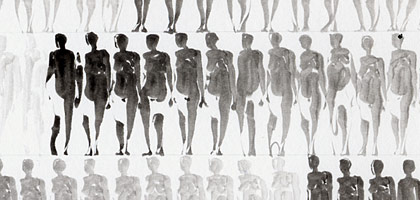
His artistic beginnings are still strongly connected to the image of reality. Having studied under Alfred Hrdlicka, the focus of his creative principles was the human body chiseled from stone. Figuration and statement were still directly related to reality; personal signature and the work process of a trained craftsman were the maxims, which were closely linked to tradition, from antiquity to Michelangelo to Rodin. Yet Niedertscheider soon took a different path. Among his last sculptures was a cube with a frieze of figures chiseled into the sides; the serial impression and form of the external appearance diminished by virtue of the intensity of mimicry and content. Subsequently Niedertscheider broke with sculpture.
The massiveness, opulence, heaviness and corporeality of his work gave way to delicate but concentrated drawings, executed with acrylic and brush. Female and male figures in groups of eight are applied to paper with delicate brush strokes, whereby the casual but direct technique maintains a sense of balance with its reference to human anatomy. With the light and dark applications of acrylic paint, the figure is built up in zones of light and shade and shaped corporeally, sometimes standing stiffly front-on, sometimes with a swing of the hips. The intensity of darkness of the paint changes in the rows of figures. Niedertscheider now introduces the human image into the medium of text, by placing man and woman into the code function. In an adaptation of the binary system, the woman stands for 0, the man for 1 (a would then be 01 000 001, b: 01 000 010, etc.). The sum of the eight figures in their systematic order constitutes a sign, a letter. The sum of the blocks of figures arranged side by side constitutes a text, for instance, the declaration of human rights or notes on the artist's work.
Niedertscheider's work process is governed by rhythm, linearity, automatism, discipline and contemplation. The artist sees meditative aspects in this internalized process and feels a bond to Zen Buddhism. To reach meditation in Zen, rhythm and breathing are necessary. The artist finds this in the process of drawing figures, which he practices in sketch books, without integrating the figures into a written code system. However, text, writing, is also required, which moves away from directly depicting optical reality through its cognitive dimension.
(Florian Steininger)
In his work on paper, which is reminiscent of scrolls, Peter Niedertscheider places the human figure as a character within the context of a code.
Consciousness for the flow of time stemming from far-eastern philosophy is felt in the process of "writing" and evident in the diminishing concentration of color in the brush.
In his work, through the monotonous movement of the brush in seemingly unending repetition, painting becomes the means to meditative worldly wisdom.
(Dr. Cornelia Cabuk)
(Roland Barthes, "Eléments de sémiologie")
A superficial glance shows what is apparently a row of monotonously repeated symbols, which almost simultaneously creates the assumption that their structure is based on a rule. The observation demands a change in focus between spatial distance that allows the eye to take in the entire picture, and another that allows its components – atoms, if you will – to be recognized individually. This one phenomenon causes the other one to disappear, and this oscillation takes place in both time and space.
The smallest unit – which can only be recognized up close – represents a human figure, both male and female. If there are only two units that can be distinguished from each other in a system, then A is the opposite of B (and not, for instance, of Z, which would only be the case within the entire alphabet). The binary opposition of man and woman in itself could produce an excess of meaning – sociological, cultural political etc. –, but it is obvious that units do not behave as opposites until a respective code has been agreed.
The impression that we get from the picture as a whole results from the organization of parts – but is this due to a higher order? We ask: What is the structural principle of the picture as a whole and does it even take shape in the phenomenon that we perceive from a distance? A group of works of the last eight years that at first would appear to be homogenous and stable offers various answers, in line with the steps of consistent artistic development.
On a first level eight iconic symbols are arranged next to each other in a row. Beginning at the upper left, these rows form columns that could be read from top to bottom – however, only if one reduces the semantics of the picture to its textual basis: one row would then correspond to a binary code of letters of a computer keyboard. The entire work represents an excerpt from Tao Te Ching, the Declaration of Human Rights or other verbal language transcriptions. However, at the same time the overall picture must leave the visual field and give way to the aesthetic focus of a strict successive flow that follows approximately the same rules as when one reads a book.
Yet all the same we gain insight into the way the artist works; the creative process can virtually be reconstructed in real time. For this the iconic symbols were optimized into a size that – after some practice – makes it possible to render them almost easily. The differences in the degree of the color grey mark the time when the artist dips his brush into the paint. However, these intervals are irregular and the process of painting the symbols gains something that is not foreseen by the code: material characteristics, production conditions and the aesthetic sensation of the artist at work.
These characteristics are reflected analogously (for instance the amount of color through the respective degree of grey). A further step foregoes intervals between discrete units, as binary coding of phonograms stipulates, as well as the digitization of verbal texts. The softening of borders between symbols and environment in the latest works leads to partial blurring of the composition of the symbols of the painting with the composition of its medium. The painting and with it the perception of it by the art viewer reproduce conditions of painting as a higher order.
If the difference between “fullness” and “form”
is the a priori prerequisite for
the existence of artistic problems,
then the interplay between “space” and “time”
is the a priori possibility for solving them.
(Erwin Panofsky)
Video
On the one hand, Peter Niedertscheider’s video work is the result of performances in which the artist himself plays a role and thereby exposes himself to observation by the viewers at his openings, and on the other from recordings of situations in museums which are objectified by his own observations, through the fixed eye of the camera. Yet both versions are the firm continuation of the themes that Niedertscheider has already approached in the medium of the painting: fixed image, space, time and viewer. What both also have in common is that they neither film the work of the sculptor nor are strictly video work, but rather sculpture with other means.
The videos of the first category – due to their filtered information of insight into depots – could be reminiscent of glyptotheca in which the artist shifts around his works by moving, pushing, stacking and adjusting them into constantly changing, new and surprising compositions. By doing this, the aura expected from the classical object is abandoned; the sculptural product is thrown back upon its tangibility. The task of making a thing of art into a work of art is delegated to the viewer. The sculptures define their place in a potentially endless process; the screen becomes a projection screen of an “open work of art“.
The relationship between work and viewer becomes the central concern in the artistic discourse and it takes its definition (literally as distancing and setting boundaries) from various perspectives. By setting boundaries to the viewers Niedertscheider quotes the classicist demand by Denis Diderot: He imagined that the ideal stage would be separated by a wall to the audience, in order to let the dramatis personae act exclusively for themselves. However, by construing this wall as a projection screen he touches the borders of producing two-dimensional images, which was the domain of painting for hundreds of years.

Thus, in the video work “Pietà“ the relationship is turned around. The actor is no longer the artist or the work of art, but an audience that is placed in the picture. The artist withdraws to his observer status in exactly the same way as was done in producing pictures in perspective ever since the Renaissance: with the fixed eye of the lens. His focus on Michelangelo’s artwork inevitably comes into conflict with the perception by the observed observers, which does not take place in space, time and movement, in changing angles, in coming and going, sometimes hastily and sometimes concentrated and frequently not at all.
Is it not because nature eternally moves in itself, eternally creates anew,
and marble, the most alive of all, stands dead, can only be saved from its
lifelessness by the magic wand of illumination?
(J. W. Goethe)
Relief
Sculpture touches its limits in the sphere of the non-graspable, atmospheric, and fleeting. However, there is no other medium in which the sculptor can be more closely compared to the painter than in the medium of relief art. While the viewer of a centrally perspective image usually gets along with one eye and a single angle to take in the object, the viewer of a sculpture needs two eyes and additionally two legs (and sometimes hands). The kinesthetic perception of a relief tends to oscillate visually and is similar to the stereoscopic point of view that takes place due to the viewing distance.
To create the illusion of space the painter lets contours blur and pale. The sculptor, who does not have the means of color at his disposal, flattens out the relief. Contrary to the painter, blurriness for him can mean the loss of spatial data, so he feels along – as in Alois Riegl – from the haptic to the optic. Where the painter begins to develop his genuine profession, the sculptor becomes a draftsman or engraver. This is shown in a comparison of late acrylic brush drawings with the stone engravings for the “Kunst-am-Bau“ project “Wohnpark Süd“, which were done about the same time.
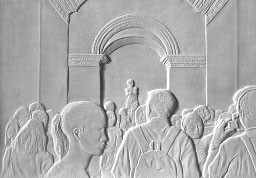
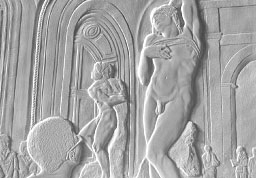
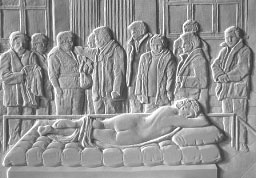
Conversely, sculpture requires exterior lighting, while light in paintings is created through the colors used by the artist. Light and shadow, lightness and contrast are not characteristics of sculpture, they occur from outside. That and how this fact takes place in the rivalry of the arts to the advantage of sculpture’s higher demand on reality, sheds light on the role perception of the recipient: The sculpture is projected – aside of its perception through the sense of touch – more directly than the painting or the video into the reality, the existing space of the viewer.
In Niedertscheider’s reliefs this fact takes on a double meaning. Due to its purity, whiteness, permanence and suitability to the monumental, marble has been the preferred material for depicting the gods and cult scenes since antiquity. Contrary to the figures for the performances created from polyester, Niedertscheider is now committed to the ideal anticipation of beauty that is manifested by the material and its history.
As a surrogate for the sculpture’s original context the museum shows, for example the “Sleeping Hermaphrodite” at the foot of its viewers, with whom it shares not only its size but also its material appearance. Only the artist and with him the observer of the scene are able to see the image from all angles, in their knowledge of the double nature of the theme. And this although they are assigned an immovable location through the orthogonal boundaries, cut off by the borders of the picture at eye level with the typical random ensemble of museum visitors. What the video develops in the chronological process is summarized here simultaneously
Rudolf Ingruber
white cube
Der Strukturalismus oder, was man unter diesem ein bisschen allgemeinen Namen gruppiert,
ist der Versuch, zwischen den Elementen, die in der Zeit verteilt worden sein mögen,
ein Ensemble an Relationen zu etablieren, das sie als nebeneinandergestellte,
einander entgegen gesetzte, ineinander enthaltene erscheinen lässt:
also als eine Art Konfiguration.
Michel Foucault
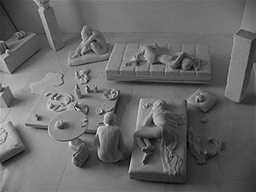
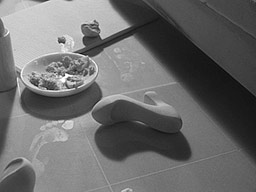
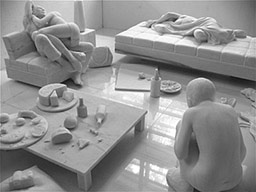
Die Entdeckung des unendlichen Raumes war, wenn auch von langer Hand vorbereitet, die Pioniertat der Renaissance. Der Raum selber wurde zum Bildgegenstand und zum Ordnungsprinzip für seine Motive. Der Süden (Italien) steuerte dazu die Richtung, der Westen (die Niederlande) die Einrichtung bei. Im Relief war die bis dahin geltende Dichotomie in Grund und Figur, Motiv und Umgebung seit Donatello Geschichte. Die Vorstellung, dass der Rahmen das Bild aus dem Raumkontinuum der Wirklichkeit schneidet, hat sich bis heute erhalten. Ihr beliebtestes Werkzeug, der Fotoapparat, ist nicht von ungefähr unter die scheinbar zufälligen Requisiten in Niedertscheiders „white cube“ geraten.
Es wird Einblick gewährt in ein Zimmer, mit einer Höhe von 90 cm, die den Maßstab für seine Bespielbarkeit vorgibt. Zwei Wände ziehen eine offene Grenze zum Raum des Betrachters und bilden zusammen mit den quadratischen Bodenfliesen ein beliebig multiplizierbares Koordinatennetz. Legt man dieses aber als Ordnungsmuster zugrunde, scheint das Szenarium einen Zustand der Unordnung zu beschreiben, dessen Deutung als Momentaufnahme einer noch unabgeschlossenen Handlung oder Erzählung sich aufdrängt. Die Bewohner des Zimmers sind sitzend und liegend, sogar im Schlaf festgehalten, und doch wird schnell deutlich, dass trotz aller Ruhe und Passivität keine der Positionen von Dauer sein kann. Höchst ungewiss ist, ob der sich anscheinend so zwanglos im Sitzmöbel räkelnde Liebhaber die Umarmung mit seiner Gefährtin noch länger durchhält. Unter all den Personen hält die am Boden Kauernde noch die beständigste Stellung, doch bleibt vorerst offen, warum die das tut.
Man ist versucht, sogar hinter und unter die Möbel zu blicken, um das Geheimnis anhand der rundum verstreuten Accessoires zu lüften und man ist auch versucht, deren Stofflichkeit zu benennen: Couch und Fauteuil aus Leder, Laken und Wäsche eventuell Seide, Glas, Keramik, Wachs und Papier, von den Speiseresten gar nicht zu reden. Dabei fehlt allen die Farbe, sind die Assoziationen allein das Ergebnis der gekonnten Behandlung des Marmors und der umfassenden Skala von Verarbeitungszuständen, zwischen poliert und pulverisiert. Wie weit der Künstler sein Spiel zu treiben vermag, fasst ein in den Raum gestelltes Kunstwerk zusammen, ein Kopf, roh behauen und mit deutlichsten Spuren des Werkzeuges – der Kettensäge des Holzbildhauers, die der Marmorbildhauer im kleineren Maßstab mit der Trennscheibe codiert. In der Konfrontation mit dem klassisch anmutenden Personal wechseln Kunst und Realität ununterbrochen die Seiten. Das Stillleben wird von einem Zeitfaktor untergraben, der sich aber nicht durch eine immanente Erzählung auflösen lässt. „Die Zeit erscheint wohl nur als eine der möglichen Verteilungen zwischen den Elementen im Raum.“
In seinem Aufsatz „Andere Räume“ arbeitet Michel Foucault den Unterschied der „aktuellen Epoche des Raumes“ zu der Zeit als „Obsession des 19. Jahrhunderts“ heraus. Gleichwohl bereitete letztere mit dem Museum, „in dem die Schöpfungen der verschiedensten Zeiten und Völker, soweit sie nur echte Schöpfungen sind, gleichberechtigt nebeneinander stehen“ (H. Sedlmayr), die „Epoche des Simultanen, der Juxtaposition, des Nahen und des Fernen, des Nebeneinander, des Auseinander“ vor. Die adäquate Begegnung mit deren Elementen äußert sich in Zitat und Verweis. Dadurch bleibt auch die Möglichkeit, sie weiterhin zum Modell für bildhauerische Studien zu wählen, legitimiert. Den Kenner freut diese Übung, die ihn durch die Identifizierung des barberinischen Fauns, des Baselitz-Kopfes, des Stoffmusters nach Keith Haring vom Banausen abhebt.
Michelangelo zitiert den Torso vom Belvedere nicht, er benutzt seine ideale Gestalt als Vorbild für das eigene Werk. Weder Banausen noch Kennern wäre es eingefallen, die Methode als einfallslos zu bezeichnen, im Gegenteil: Michelangelo selbst riet den Zeitgenossen, sich nicht nur im Naturstudium, sondern vor allem im Studium der Alten zu üben. Winckelmann erneuert gut zweihundert Jahre später den Ratschlag. Für ihn aber ist die ideale Gestalt weit weniger Ausdruck von Kunst als ein Produkt der Natur. Ein Körper, ein Muskel wächst eben so, wenn das natürliche Erbe gut ist und durch natürliche Aktivitäten veredelt. Hingegen hypotrophiert das Geschlecht. Niedertscheiders Studienobjekte überführen das kunstgeschichtliche Erbe in die unmittelbare Jetztzeit, als deren maßstabsgetreues Modell sie sich erweisen und für die das moderne Ambiente, die Kleider und die Frisuren, Beobachtungsniederschläge des Hier und des Heute, die äußerliche Bestätigung sind.